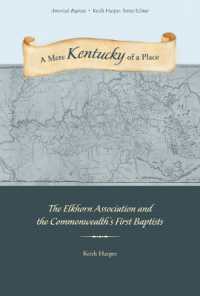- ホーム
- > 洋書
- > 英文書
- > Performing Arts
Full Description
From the mid-90s to the present, television drama with religious content has come to reflect the growing cultural divide between white middle-America and concentrated urban elites. As author Charlotte E. Howell argues in this book, by 2016, television narratives of white Christianity had become entirely disconnected from the religion they were meant to represent. Programming labeled 'family-friendly' became a euphemism for white, middlebrow America, and developing audience niches became increasingly significant to serial dramatic television. Utilizing original case studies and interviews, Divine Programming investigates the development, writing, producing, marketing, and positioning of key series including 7th Heaven, Friday Night Lights, Rectify, Supernatural, Jane the Virgin, Daredevil, and Preacher.
As this book shows, there has historically been a deep ambivalence among television production cultures regarding religion and Christianity more specifically. It illustrates how middle-American television audiences lost significance within the Hollywood television industry and how this in turn has informed and continues to inform television programming on a larger scale. In recent years, upscale audience niches have aligned with the perceived tastes of affluent, educated, multicultural, and-importantly-secular elites. As a result, the televised representation of white Christianity had to be othered, and shifted into the unreality of fantastic genres to appeal to niche audiences. To examine this effect, Howell looks at religious representation through four approaches - establishment, distancing, displacement, and use - and looks at series across a variety of genres and outlets in order to provied varied analyses of each theme.
Contents
List of Figures
Introduction: Christianity, Religion, and Hollywood Television Production Cultures
Two Preachers, 2016 and 1996
Understanding Religion in Hollywood's Production Culture
The Boom in Religious Representation in the Post-Network Era (early 2000s-2016)
Religion Among Expansive Options: Toward Peak TV (2015-2016)
Methods and Chapters
Part One: Establishing White Christianity's Middlebrow Associations
Chapter One - Christianity's Broad Appeal in the 1990s: Touched by an Angel and 7th Heaven
A Brief History: Establishing The Norms of Representing Christianity on American Television
The Neo-Network Legacy: Defining and Avoiding "Religious TV" Within Middlebrow Appeal
Old Networks and New Netlets: Broadcast in the Neo-Network Era
Religious Messages and the Middlebrow Audience: Touched by an Angel
Attempting to Avoid "Preachy" : 7th Heaven
Conclusion
Chapter Two - Biblical Miniseries in the 2010s: Mark Burnett, Roma Downey, and Faithful Christian Representation
Touched by an Angel as Model: Roma Downey and Mark Burnett's Pursuit of Faithful TV in an Increasingly Upscale-oriented Industry
The Bible Miniseries: The Rewards of Risk for the History Channel
A.D.: The Bible Continues and The Dovekeepers: Failures of Faith on Network Television
The Persistent Perception of Antagonism between Faith and Mainstream Television
Part Two: Distancing Christianity Through Place and Race
Chapter Three - Southern Realism: Christianity in Friday Night Lights and Rectify
Christianity in Quality Representations of the American South
Southern Realism and Authenticity Claims in the Post-Network Era
Heartland Subjects, Quality Audience: Friday Night Lights
Authentic Artistic Vision, Quality Channel: Rectify
Conclusion
Chapter Four - Non-White Christian Dramas: Exploration through Otherness in Jane the Virgin and Greenleaf
Latinx Catholicism on TV
The Tele-Novelty of Jane the Virgin's Catholicism
Christianity and Black TV Identity
Oprah's Soap Opera on the Megachurch Pulpit: Greenleaf
Conclusion
Part Three: Displacing Christianity in Fantastic Genres
Chapter Five - Religion as Unreality: Fantastic TV's Generic Displacement of Christianity
Containment Through Displacement: Battlestar Galactica
Abstraction to Supernatural Spirituality: Lost
Minimizing Genre, Maximizing Quality: The Leftovers
Adapting Edginess and the Pursuit of God: Preacher
Conclusion
Chapter Six - The Biblical Book of Revelation as Mythology: Apocalyptic TV
The Post-Christian End of the World and Apocalyptic Television
Containment Through Pastiche: Supernatural
Containment Through Denial: Dominion and Constantine
Conclusion
Part Four: Acknowledging Christianity in the Era of Peak TV
Chapter Seven - Streaming Religion: Netflix's Daredevil and Amazon's Hand of God
Peak TV is Still TV: New Television, Old Ideologies
Netflix and Amazon: History, Branding, and Models of Success in a Changing Industry
Religion in the Context of Marvel's Brand: Daredevil
Religion to Cultivate Edge: Amazon's Hand of God
Conclusion
Conclusion - Polarized Culture and Dual Approaches to Christianity on TV
The Tipping Point
Appendix A: Interviews
Bibliography







